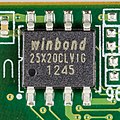| Fastboot | |
|---|---|
 Fastboot text-based user interface | |
| Original author | Google LLC |
| Repository | android.googlesource.com |
| Included with | Android SDK |
| Available in | C++ |
| Type | Firmware communication protocol and implementation thereof |
Fastboot is a communication protocol used primarily with Android devices. [1] It is implemented in a command-line interface tool of the same name and as a mode of the bootloader of Android devices. The tool is included with the Android SDK package and used primarily to modify the flash filesystem via a USB connection from a host computer. It requires that the device be started in Fastboot mode. If the mode is enabled, it will accept a specific set of commands, [2] sent through USB bulk transfers. Fastboot on some devices allows unlocking the bootloader, and subsequently, enables installing custom recovery image and custom ROM on the device. Fastboot does not require USB debugging to be enabled on the device. [3] To use fastboot, a specific combination of keys must be held during boot. [4]
Contents
Not all Android devices have fastboot enabled, [5] and Android device manufacturers are allowed to choose if they want to implement fastboot or some other protocol. [6]
